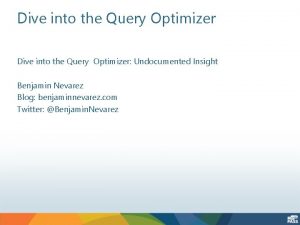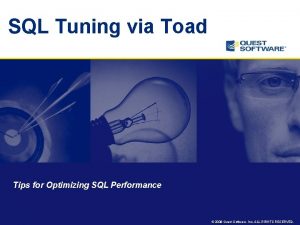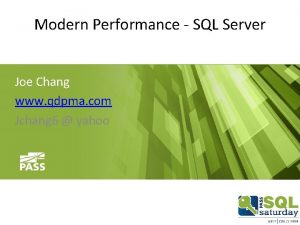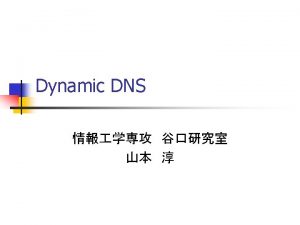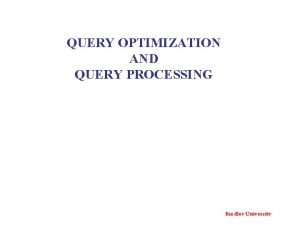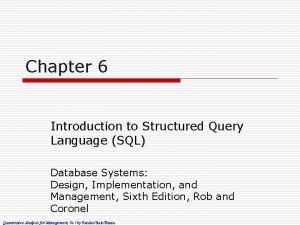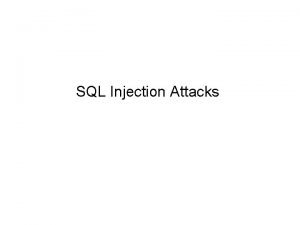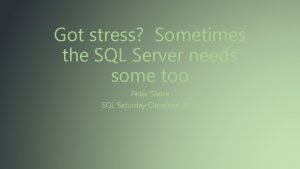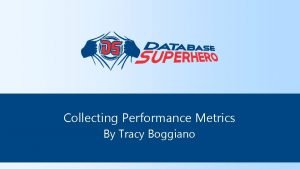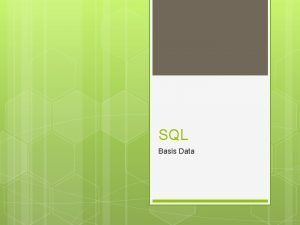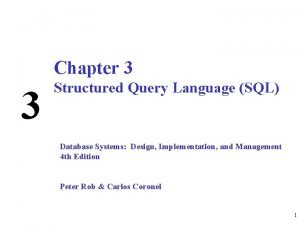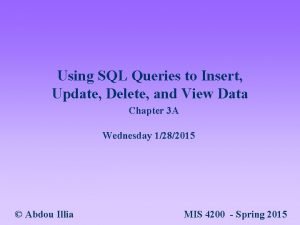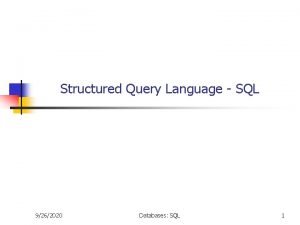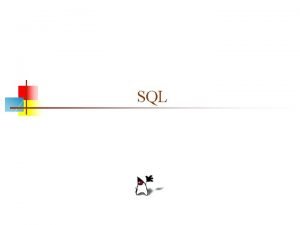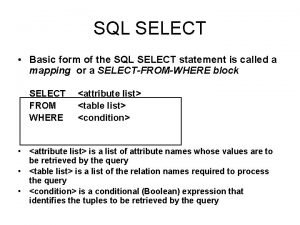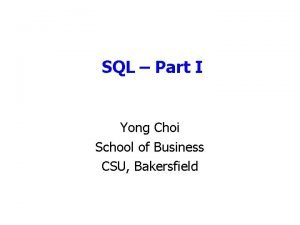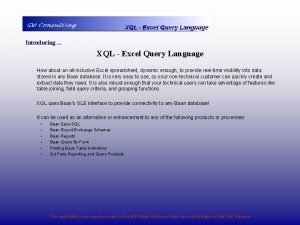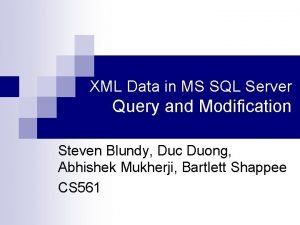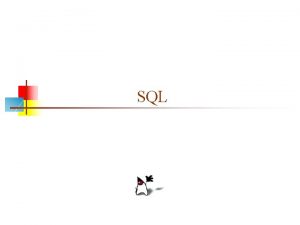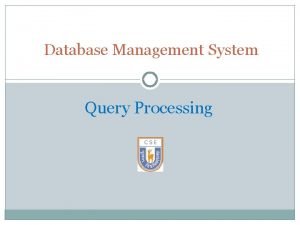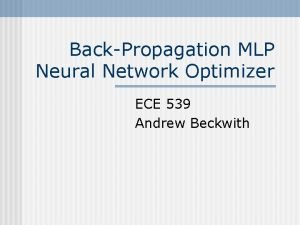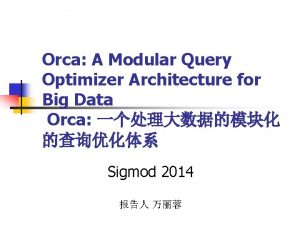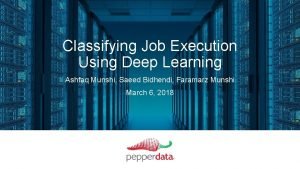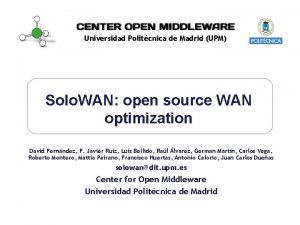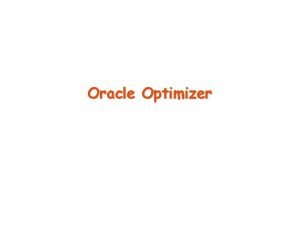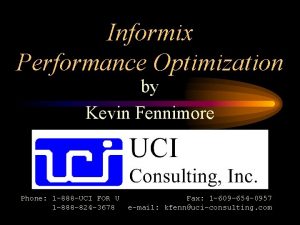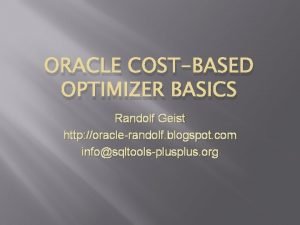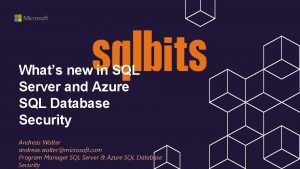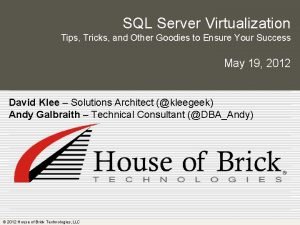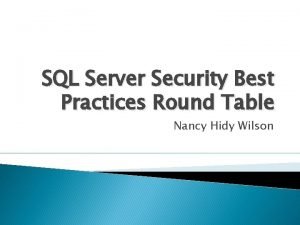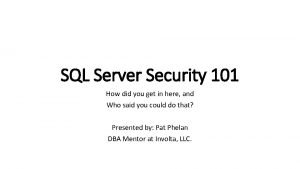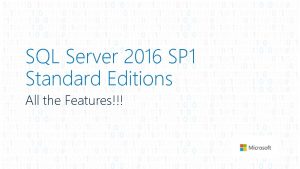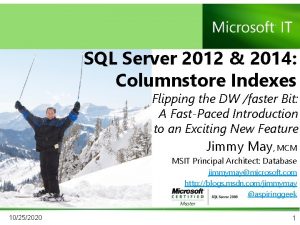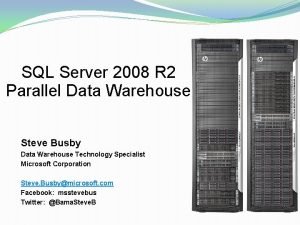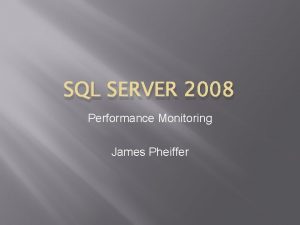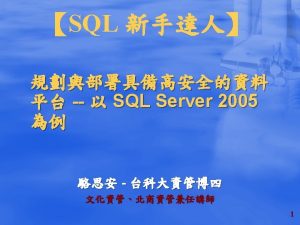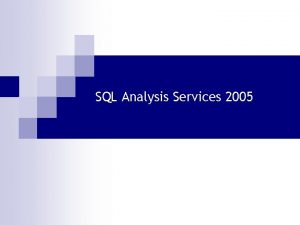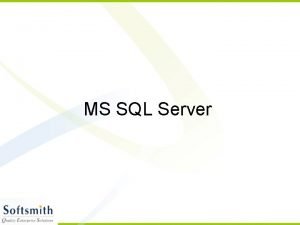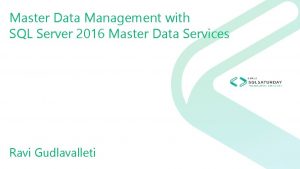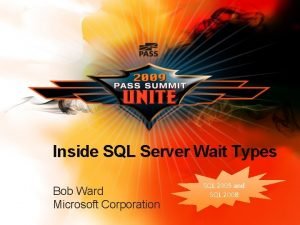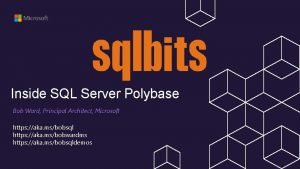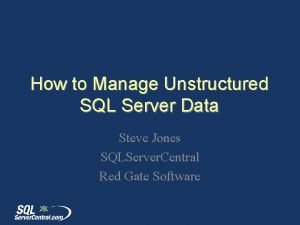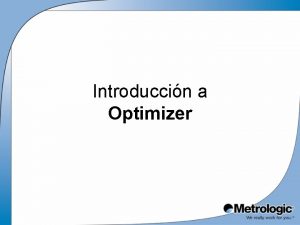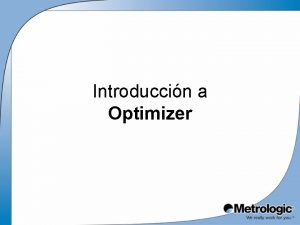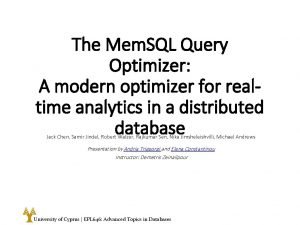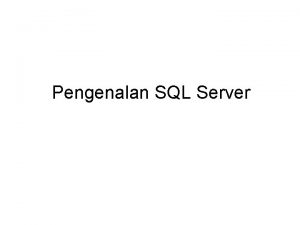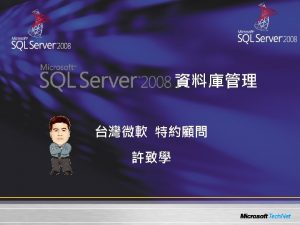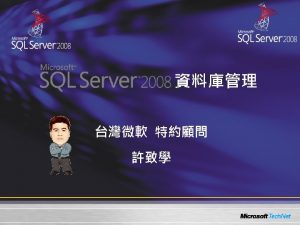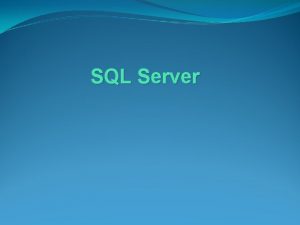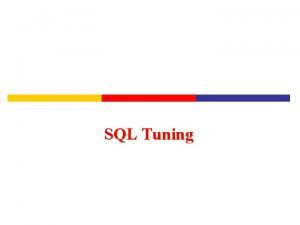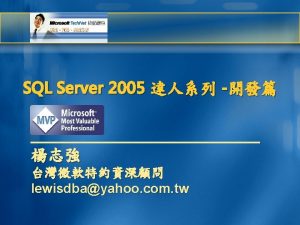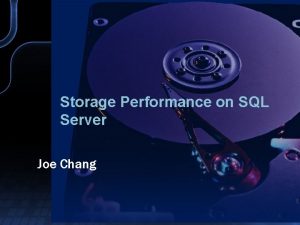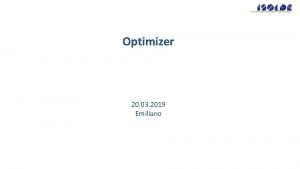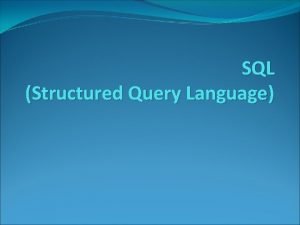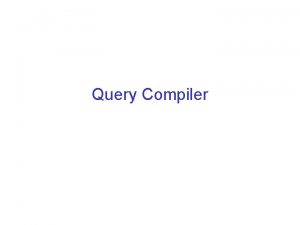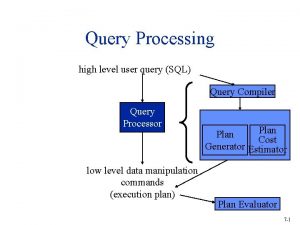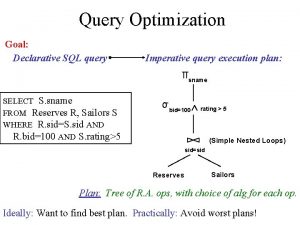SQL Server Query Optimizer Cost Formulas Joe Chang

































































- Slides: 65

SQL Server Query Optimizer Cost Formulas Joe Chang jchang 6@yahoo. com www. qdpma. com , www. solidq. com

Scope - Query Optimizer Parse SQL Execution Plans Cost Model Rows and pages in each operation Data Distribution Statistics Estimate rows and pages Sources – David Dewitt, Conor Cunningham

Query Optimizer References Conor Cunningham Chapter in Inside SQL Server Conor vs. SQL http: //blogs. msdn. com/b/conor_cunningham_msft/ David Dewitt PASS 2010 Summit Keynote Search: Microsoft Jim Gray Systems Lab http: //www. slideshare. net/Gray. Systems. Lab/pass-summit-2010 -keynote-david-dewitt http: //www. slideshare. net/Gray. Systems. Lab/pass-summit-2010 -keynote-daviddewitt/download

My material http: //www. qdpma. com/CBO/SQLServer. Co st. Based. Optimizer. html http: //www. qdpma. com/z. Presentations. ht ml

Paul White – Page Free Space http: //sqlblog. com/blogs/paul_white/default. aspx Inside the Optimiser: Constructing a Plan – Part 4 http: //sqlblog. com/blogs/paul_white/archive/2010/07/31/insid e-the-optimiser-constructing-a-plan-part-4. aspx DBCC RULEON/RULEOFF Inside the Optimizer: Plan Costing http: //sqlblog. com/blogs/paul_white/archive/2010/0 9/01/inside-the-optimizer-plan-costing. aspx DBCC TRACEON (3604); -- Show DBCC output DBCC SETCPUWEIGHT(1 E 0); -- Default CPU weight DBCC SETIOWEIGHT(0. 6 E 0); -- I/O multiplier = 0. 6 DBCC SHOWWEIGHTS; -- Show the settings

Execution Plan Cost Model Index Seek + Key Lookup – Table Scan Joins – Loop, Hash, Merge Updates (Includes Insert & Delete) Really complicated, not covered here Parallel Execution Plans

Why this is Useful? When does the QO use: an index versus table scan Loop Join or Hash/Merge with Scan? Is there a difference between the Cost Model and True Cost Structure? Should I use query hints Parallel Execution Strategy Modern servers – 64+ cores

SQL Server Books Online Query Governor Cost Limit Query cost refers to the estimated elapsed time, in seconds, required to complete a query on a specific hardware configuration. Cost Threshold for Parallelism The cost refers to an estimated elapsed time in seconds required to run the serial plan on a specific hardware configuration. … SQL Server creates and runs a parallel plan for a query only when the estimated cost to run a serial plan for the same query is higher than the value set in cost threshold for parallelism.

Adventure Works Example


Estimated Execution Plan

Clustered Index Scan

Index Seek

Index Seek + Key Lookup

Heap Table

Heap Operations

The Formula – Seek, Scan (Clustered) Index Scan, Table Scan, Index Seek IO Cost 0. 003125 + 0. 00074074 per page CPU Cost 0. 0001581 + 0. 0000011 per row

Key Lookup (& Loop Join) Key/RID Lookup, Nested Loops Join IO Cost 0. 003125 x % that require Lookup CPU Cost 0. 0001581 per Lookup 0. 0000011 per additional rows

IO Cost Model Sequential - Random Cost is elapsed time in seconds Random Sequential 0. 003125 = 1/320 0. 00074074… = 1/1350 Random: 320 IOPS Sequential 1350 pages/sec, or 10. 8 MB/s

Key Lookup – Scan Cross over Key Lookup rows to pages scanned ratio 1 Key Lookup cost approximately 4 pages in scan operation Non-parallel plan, with other costs Cross-over approx 3. 5 pages per KL row Parallel Plan Closer to 4 pages per Key Lookup row


Loop, Hash and Merge Joins

LHM

Sort

Loop Hash and Merge Cost Fixed Loop ~0. 0 + seek cost: 0. 003125 IO, Incremental 0. 00000418 + Seek 0. 0001581 CPU Hash ~0. 017780 Merge ~0. 005607 Many-to-Many Merge Sort ~0. 011261 0. 00001526* 0. 00000238† 0. 00004738 * Hash incremental cost depends on inner/outer source size † Merge join incremental is per IS & OS row? Merge + Sort fixed cost approx same as Hash fixed cost

Loop, Hash, Merge Cost Fixed Incremental Loop Zero High Hash High Medium Merge Medium Low Merge Join requires both source rows in index sorted order. Regular Merge only for 1 -1 or 1 -many Many-to-many merge join is more expensive




Plan Cross-over Theory Cost Index Seek + Key Lookup Table Scan Rows

Theory & Actual? Cost KL Actual! KL Theory Table Scan KL alternate reality? Rows

Plan and Actual IO Random Sequential Ratio Plan 320 1, 350 (10. 8 M/s) Current HD 200* 12, 800 (100 MB/s) 64* SAN 200 1, 280 (10 MB/s) 6. 4 SSD 20, 000 25, 000 *Note: original slide incorrectly listed 640: 1 4. 2187 ~1


Loop, Hash & Merge


Loop Join

Merge Join

Hash Join

Insert, Update & Delete Really complicated See material from Conor For large number of rows (25%? ) Consider dropping indexes

Delete Rows Index foreign keys when: Deletes from primary table are frequent


Parallel Execution Plans Parallel Execution Parallelism Gather, Repartition, Distribute Streams, Partitions

Parallel Execution Plan

Parallel Operations Distribute Streams Non-parallel source, parallel destination Repartition Streams Parallel source and destination Gather Streams Destination is non-parallel Bitmap

Scan

2 X DOP 1 DOP 2 IO Cost same CPU reduce by degree of parallelism, except no reduction for DOP 16 8 X 4 X DOP 4 DOP 8 IO contributes most of cost!

DOP 8 DOP 16

IO Cost is the same CPU cost reduced in proportion to degree of parallelism, last 2 X excluded? On a weak storage system, a single thread can saturate the IO channel, Additional threads will not increase IO (reduce IO duration). A very powerful storage system can provide IO proportional to the number of threads. It might be nice if this was optimizer option? The IO component can be a very large portion of the overall plan cost Not reducing IO cost in parallel plan may inhibit generating favorable plan, i. e. , not sufficient to offset the contribution from the Parallelism operations. A parallel execution plan is more likely on larger systems (-P to fake it? )

Partitioned Tables Regular Table Partitioned Tables No Repartition Streams operations!


Parallel Execution: Super Scaling Suppose at DOP 1, a query runs for 100 seconds, with one CPU fully pegged CPU time = 100 sec, elapse time = 100 sec What is best case for DOP 2? Assuming nearly zero Repartition Threads cost CPU time = 100 sec, elapsed time = 50? Super Scaling: CPU time decreases going from Non. Parallel to Parallel plan! No, I have not been drinking, today, yet

Super Scaling CPU normalized to DOP 1 CPU-sec goes down from DOP 1 to 2 and higher (typically 8) Speed up relative to DOP 1 3. 5 X speedup from DOP 1 to 2 (Normalized to DOP 1)

Most probable cause Bitmap Operator in Parallel Plan Bitmap Filters are great, Question for Microsoft: Can I use Bitmap Filters in OLTP systems with non-parallel plans?

Negative Scaling Query time “Speedup”

CPU

Small Queries – Plan Cost vs. Act Plan Cost Query 3 and 16 have lower plan cost than Q 17, but not included Q 4, 6, 17 great scaling to DOP 4, then weak Query time Negative scaling also occurs

CPU time Speed up What did I get for all that extra CPU? , Interpretation: sharp jump in CPU means poor scaling, disproportionate means negative scaling Query 2 negative at DOP 2, Q 4 is good, Q 6 get speedup, but at CPU premium, Q 17 and 20 negative after DOP 8

Parallel Exec – Small Queries Why? Almost No value OLTP with 32, 64+ cores Parallelism good if super-scaling Default max degree of parallelism 0 Seriously bad news, especially for small Q Increase cost threshold for parallelism?

Parallel Settings - Strategy Mostly for OLTP Cost Threshold for Parallelism Default: Plan Cost > 5: Proposed: 20 -100 In 1997, Pentium Pro 200 MHz, ~5 sec for 50 MB table (index range) scan Today, Xeon 5680, 3. 3 GHz, ~ 30 X faster Parallel plan could run 10 -100 milli-sec

Parallel Settings - Strategy Mostly for OLTP Cost Threshold for Parallelism Default: Plan Cost > 5: Proposed: 20 -100 In 1997, Pentium Pro 200 MHz, ~5 sec for 50 MB table (index range) scan Today, Xeon 5680, 3. 3 GHz, ~ 30 X faster Parallel plan could run 10 -100 milli-sec

Parallel Settings - Strategy Cost Threshold for Parallelism Default: Plan Cost > 5: Proposed: 20 -100 In 1997, Pentium Pro 200 MHz, ~5 sec for 50 MB table (index range) scan Today, Xeon 5680, 3. 3 GHz, ~ 30 X faster Parallel plan could run 10 -100 milli-sec Max Degree of Parallelism (OLTP) Default: 0, unrestricted, Proposed: 2 -4 Use OPTION (MAXDOP n)


Too Many Indexes Complicates Query Optimization Too many possible execution plan Large Updates – Maintenance Consider dropping indexes

Parameters and Variables Unknown, remote source Remote Scan: 10, 000 rows Remote Seek xxx rows Unknown >, <, BETWEEN > or <: 30% of rows BETWEEN: 1/10 of rows

Temp tables and Table Variables
 Query optimizer sql server
Query optimizer sql server Inside the sql server query optimizer
Inside the sql server query optimizer Sql server intelligent query processing
Sql server intelligent query processing Toad sql tuning
Toad sql tuning Joe chang
Joe chang Sp_cursorprepexec
Sp_cursorprepexec Iterative query vs recursive query
Iterative query vs recursive query Query tree and query graph
Query tree and query graph Query tree and query graph
Query tree and query graph Lir
Lir Introduction to structured query language (sql)
Introduction to structured query language (sql) Introduction to structured query language (sql)
Introduction to structured query language (sql) An attacker injects the following sql query blah
An attacker injects the following sql query blah Sql query stress
Sql query stress Whoisactive sql query
Whoisactive sql query Singkatan dari structured query language adalah
Singkatan dari structured query language adalah A structured query language – sql operators are
A structured query language – sql operators are Select * from tab
Select * from tab Sql insert update delete query
Sql insert update delete query Update sql command
Update sql command Structured query language (sql) is an example of a(n)
Structured query language (sql) is an example of a(n) Basic form of sql query
Basic form of sql query Sql yong
Sql yong Cosmos db query optimization
Cosmos db query optimization Excel sql query
Excel sql query Sql query for xml
Sql query for xml Sql stands for
Sql stands for Steps of query processing
Steps of query processing Nascar optimizer
Nascar optimizer Kaizen event charter
Kaizen event charter Runzheimer logistics optimizer
Runzheimer logistics optimizer Orca model
Orca model Display campaign optimizer
Display campaign optimizer Pepperdata capacity optimizer
Pepperdata capacity optimizer Wan optimizer open source
Wan optimizer open source Types of optimizer in oracle
Types of optimizer in oracle Image optimizer
Image optimizer Eq optimizer
Eq optimizer Randolf david
Randolf david Axioma optimizer
Axioma optimizer The chemical detective
The chemical detective Difference between sql and pl/sql
Difference between sql and pl/sql Sql developer real time sql monitor
Sql developer real time sql monitor Azure secure enclave
Azure secure enclave Iometer vmware
Iometer vmware Microsoft sql server security best practices
Microsoft sql server security best practices Sql server security basics
Sql server security basics Sql server 101
Sql server 101 How to monitor log shipping in sql server 2005
How to monitor log shipping in sql server 2005 Privisol
Privisol Microsoft sql server compact edition
Microsoft sql server compact edition Sql server 2016 sp
Sql server 2016 sp Sql server always on architecture diagram
Sql server always on architecture diagram Sql server columnstore index best practices
Sql server columnstore index best practices Microsoft sql server 2012 parallel data warehouse
Microsoft sql server 2012 parallel data warehouse Pssdiag
Pssdiag Sql server 組態管理員
Sql server 組態管理員 Sql server 2005 performance
Sql server 2005 performance Microsoft sql server 2005 analysis services
Microsoft sql server 2005 analysis services Microsoft sql server machine learning
Microsoft sql server machine learning Microsoft sql server introduction
Microsoft sql server introduction Sql server management studio express 2012
Sql server management studio express 2012 Sql 2016 master data management
Sql 2016 master data management Bob ward microsoft
Bob ward microsoft Mpdwsvc.exe mpdwsvc application
Mpdwsvc.exe mpdwsvc application Varbinary in sql server
Varbinary in sql server

